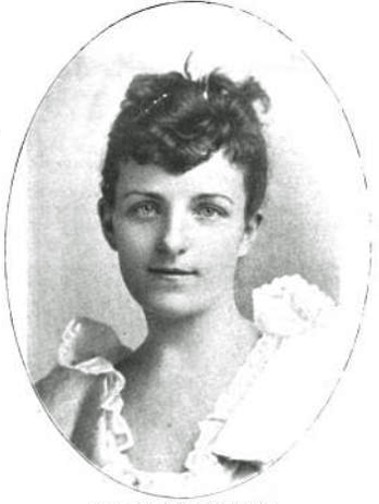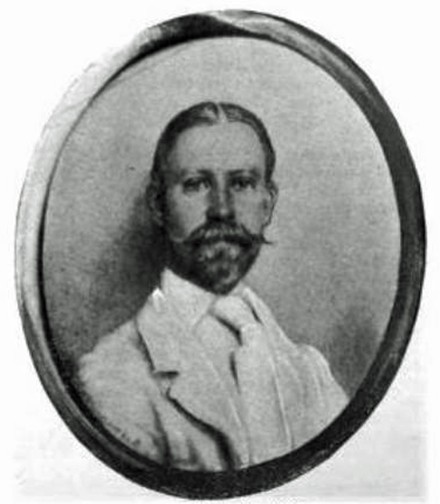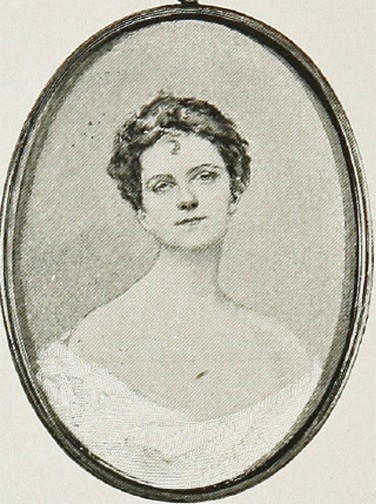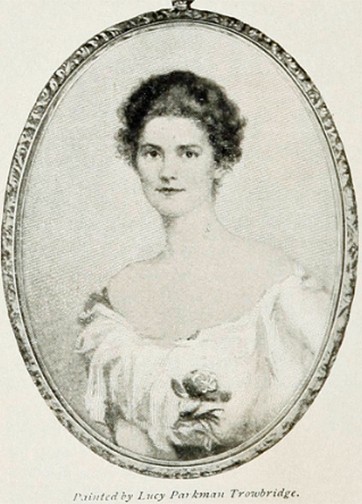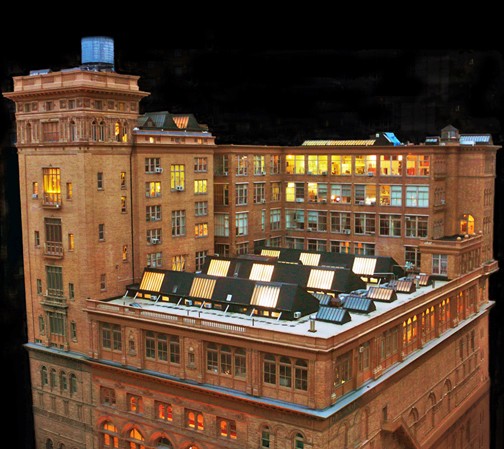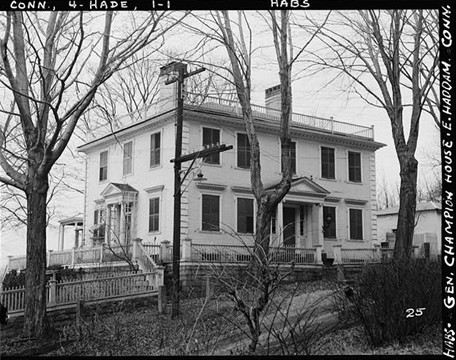Lucy Parkman Trowbridge, 1859 – 1943
Lucy Parkman Trowbridge was a miniaturist born on May 7, 1859 into a prominent family in Washington, D.C. Her mother was Lucy Parkman of Savannah, Georgia, the last of her family to survive the sinking of the Pulaski steamship in 1838. Her father, William Petit Trowbridge, had been a Major General in the U.S. Army. He also enjoyed a successful scientific career that included engineering professorships at Yale and Columbia in the last years of his life. Lucy was the second of eight children but not much else is known about her childhood. A brief notice in the May 9, 1891 issue of Harper’s Bazaar reported that Lucy and her sister Kate “directed all the costuming of the recent performers in Antigone at New Haven. They had made a careful study of the work, and the result was peculiarly successful” (359).
Trowbridge studied at the Yale School of Fine Arts between 1877 and 1881, earning a certificate for completing a three-year course. In 1893, she was on the State Board of Lady Managers of the World's Columbian Exposition. "Lucy helped organize the [...] Exposition, working on both the women's exhibit and the Connecticut state building" (Fahlman 16).
An 1896 article praising her artistic talent appeared in the Commercial Gazette (and was reprinted in several other newspapers):
Gifted from her youth with an artistic perception, it was the earnest hope, and desired wish, of her friends that she should have the advantages resulting from study abroad. Technically, perhaps, quite as much may be learned here at home, but one loses the valuable environment of the Paris studios (1).
Trowbridge trained in Paris for three years at the Académie Julian and with Frederick MacMonnies (Hartford Courant, April 12, 1943, 6). She is also said to have worked with "Armand Jean" (a misspelling of Edmond Aman-Jean). She was listed in the 1896 Indicateur guide as a resident at 4 rue de Chevreuse; whether she ever lived elsewhere in Paris is unknown, but her studio was located in a passage near Rue de Vaugirard. Katharine de Forest, columnist for Harper’s Bazaar, published a delightful description of Trowbridge’s studio on June 12, 1897:
Not less attractive, but in quite a different genre, is the studio of another young American miniature-painter, Miss Lucy P. Trowbridge. To find it you must go to the ‘Surrey side of the Seine,’ where you walk along the Rue de Vangirard [sic], turn into one of those irregular passages that are such a feature of Paris, and mount a flight of steps to the wooden balcony of a little brown chalet with a broad overhanging roof. Tucked away under it are two studios, that of Miss Trowbridge and her friend Anna Osgood, who has had a picture received this year at the Champ de Mars. Miss Trowbridge was not only made an associée last year of the Salon of the Champ de Mars, but has been accepted this year at the Royal Academy in London. She studied first at the New Haven Art School, and then with Macmonnies in Paris; and what I love about her miniatures is the impression they give of having been done from life, the personality and temperament in the portraits, their delightful tone. Half the miniatures one sees are only colored photographs. Miss Trowbridge’s studio is simple but charming. It gives one a fascinating impression of harmonious and refined color. There is a divan in old-blue, with pillows of deep orange; a screen over which are thrown bits of antique silks in pale pinks and blues and faded reds; there are choice bits of old silver and quaint bric-à-brac; but everything is dainty, delicate—it is the milieu of a miniature-painter, in short (483).
Like so many of her compatriots, Trowbridge traveled while she was in Paris, visiting Spain, Italy, England, and other parts of France.
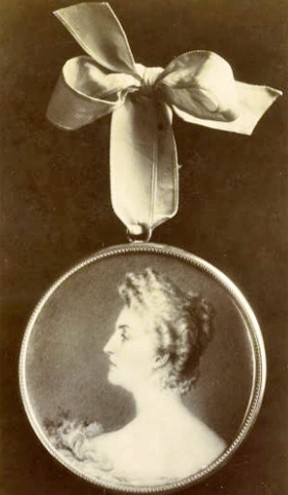
She exhibited miniatures at the Salon des Beaux-Arts three times (1896, 1897, 1898), earning critical acclaim for her work. Among Trowbridge’s early miniatures was one of Sara Roosevelt, mother of future president Franklin Delano Roosevelt.
In June 1896, Harper's Bazaar included a small article about Trowbridge’s successes in Paris, noting that she had gone abroad in 1895. She earned first place in the Salon du Champs-de-Mars (Salon des Beaux-Arts) for her three miniatures in 1896.
"Four thousand pictures were entered for this contest. Of this large number but twelve received 'No 1,' and Miss Trowbridge's miniatures of Mrs. Danton, Miss Catharine Caldwell, and Howard Hart were of these twelve chosen art apostles" (Commercial Gazette 1).
The "still greater honor" of becoming an associate of the Salon was soon bestowed upon her. "This honor comes to but few, most painters having to wait until middle age, and some never know it at all" (Harper's Bazaar, June 20, 1896, 531). The article also reported that she studied at the Art Students League in New York before going abroad, and declared, “Her pluck is indomitable.” Another article, by Frank S. Richards for the May 1896 issue of The Illustrated American, extols Trowbridge as “our American Kauffman,” comparing her to the immensely successful eighteenth-century Swiss neoclassical painter, Angelica Kauffman. Richards continues his hyperbolic praise by concluding, “Miss Trowbridge’s achievements will doubtless live as truly as have the examples of her most noted predecessors” (312).
Her local hometown newspaper also reported on the success she found in Paris:
Miss Trowbridge has more than fulfilled what was expected of her. Leaving her home in New Haven, Conn., only about a year ago, she has succeeded in accomplishing her aim with remarkable celerity and success. Miss Trowbridge’s special metier in the painting of miniatures, and to this walk of art life, less crowded than other highways, she has devoted her attention (New Haven Daily Morning Journal and Courier 6)
Trowbridge returned to the United States between 1897 and 1898. In 1897, one of her portrait miniatures was shown at the Water Color Club's Tenth Annual Exhibition in Boston. The April 8, 1898 issue of Harper's Bazaar featured a review of the exhibition of the Society of American Artists that complimented a number of women miniature painters. Lucy Parkman Trowbridge is described as one exhibitor "worthy of notice" (312). In 1899, an article by Abby Watkins Hathaway in the Detroit Free Press described the resurgent popularity of miniature portrait painting and listed Trowbridge as one of the notable American women producing such miniatures (C5). Yet another article about women miniaturists appeared in a 1901 issue of The Cosmopolitan, featuring several of her detailed, delicate portraits. Trowbridge and fellow Girls’ Art Club alumna Harriette Strafer were described as “women whose work speaks for itself and derives no adventitious aid from the rank or name of sitters” (de Kay 332).
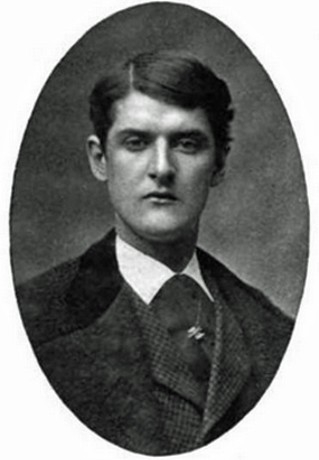
In 1899, Trowbridge married attorney Francis G. Ingersoll, the son of former Governor of Connecticut Charles R. Ingersoll. It appears that the Trowbridges and Ingersolls had a long-standing relationship: Lucy's father had served as adjutant general for Charles Ingersoll through all his terms as governor. Francis attended Yale Law School, graduating with an L.L.B. in 1877, before working as an attorney for several businesses and retiring in the early twentieth century (Biographical Record 122). Their wedding was covered by the local New Haven newspaper, The Morning Journal-Courier, on October 11, 1899. The ceremony and reception were held at her mother's home in New Haven. We also learn from the wedding announcement that: “After their wedding trip Mr. and Mrs. Ingersoll will live at Carnegie hall, where Mrs. Ingersoll has had her studio for a few years past” (7).
Trowbridge must have been among the first artists to benefit from the studios (she secured one in 1898), built with the financial support of Andrew Carnegie in 1894, shortly after the opening of the Carnegie concert hall in 1891. The studios were specifically conceived to create a unique living and working environment for actors, dancers, architects, playwrights, literary agents, photographers, and painters. The income derived from the rentals would offset the deficits generated by the concerts performed at the Hall. Studio spaces were specially designed for artistic work, with very high ceilings, skylights, and large windows to let in natural light:
For over 100 years, some of the 20th century’s most significant artists and performers lived and worked in the 165 studios that lay hidden atop Carnegie Hall. The studios were rented by creative people of all stripes, from fashion designers to painters and ballerinas, an eccentric mix to be sure. Some lived there (Schneider).
Lucy completed a B.F.A. at the Yale School of Fine Arts in 1903, alongside New Haven-born Edward Peck Sperry (1851 – 1925), who would become a prolific stained-glass designer, working for Tiffany & Co. after his training overseas in Paris and Rome (Wingerson 46). Intended only for “students who have made special attainments and have given evidence of marked ability in their work,” the B.F.A. required two years of study, the submission of a written thesis, and original work in painting or sculpture (Schiff). According to Fahlman, "[...] of the 28 B.F.A.s awarded between 1891 and 1913, only four went to women: Josephine Miles Lewis (1891), Lucy Parkman Trowbridge Ingersoll (1903), Mary Foote (1906), and Irene Weir (1906). The first woman artist awarded an honorary degree was Cecilia Beaux in 1912" (23).
Despite completing her B.F.A., Trowbridge did not seriously continue her career as an artist after her marriage. A 1915 article in the Hartford Courant describes her as the owner of a tea house in East Haddam, CT:
Mrs. Ingersoll, who was formerly Lucy Trowbridge, a well known miniature painter of New Haven and a distinguished member of that family in the Elm City, is assisted by her husband, Francis R. Ingersoll, a son of Governor Charles R. Ingersoll. The tea house which has many patrons and is much appreciated is in reality the old home of General Champion, a well known figure in the Revolutionary War [...] Dainty lunches are served there as well as daily afternoon teas"(16).
According to her passport application on Ancestry.com, she traveled for six months in 1922 to Holland, Germany, France, Italy, Belgium, Slovakia, Greece, and Egypt.
Even though numerous articles identify the Ingersolls as childless, the couple had one daughter, Lucy, born in 1901, who tragically died in Haddam in 1924, possibly by suicide.

Lucy Parkman Trowbridge Ingersoll died in New Haven on April 11, 1943 at the home of her sister, her only surviving relative (Hartford Courant, April 12, 1943, 6).
No other information about her life has surfaced.
Sources
- “American and British Women.” The Evening Journal, November 13, 1896, p. 4. Newspapers.com.
- Ancestry.com (Columbia University Libraries subscription).
- "Brief Mention." New Haven Daily Morning Journal And Courier, June 29, 1898, p. 8. NewspaperArchive.com.
- Catalogue of Yale University, 1903-1904. New Haven: The Tuttle, Morehouse & Taylor Company, 1903, p. 440. Google Books.
- de Forest, Katharine. “Our Paris Letter.” Harper’s Bazaar, vol. 29, no. 20, May 16, 1896, p. 419. ProQuest.
- de Forest, Katharine. “Our Paris Letter.” Harper’s Bazaar, vol. 29, no. 48, November 28, 1896, pp. 990-991. ProQuest.
- de Forest, Katharine. “Our Paris Letter.” Harper’s Bazaar, vol. 30, no. 24, June 12, 1897, p. 483. ProQuest.
- de Kay, Charles. “The Miniator’s Art.” The Cosmopolitan, vol. 30, no. 4, February 1901, pp. 331-338. ProQuest.
- Fahlman, Betsy. “Women Art Students at Yale, 1869-1913: Never True Sons of the University.” Woman’s Art Journal, vol. 12, no. 1, Spring-Summer 1991, pp. 15-23. JSTOR.
- “Francis Gregory Ingersoll.” Biographical Record of the Class of 1874 in Yale College, part 4. New Haven: The Tuttle, Morehouse & Taylor Co., 1912, pp. 121-122. Google Books.
- French, Lillie Hamilton. “The Portrait Show.” Harper’s Bazaar, vol. 31, no. 53, December 31, 1898, p. 1132. ProQuest.
- "General Epaphroditus Champion House, East Haddam, Middlesex County, CT." Historic American Buildings Survey, Library of Congress.
- Hathaway, Abby Watkins. “Miniature Portrait Painting; Revival of a Once Highly Favored Art.” Detroit Free Press, February 12, 1899, p. C5. ProQuest.
- “Honors to Woman Artist.” The Daily Democrat, June 1, 1896, p. 6. Newspapers.com.
- "Lucy Parkman Ingersoll." Find-A-Grave.com.
- “Lucy Trowbridge Ingersoll Dies.” Daily Boston Globe, April 12, 1943, p. 7. ProQuest Historical Newspapers.
- "Miss Trowbridge, an American Girl, Excels in Miniature Painting." The Commercial Gazette, June, 7,1896, p. 1. Newspapers.com.
- "Mrs. Lucy Ingersoll New Haven Artist." New York Times, April 12, 1943, p. 23.
- “Noted Artist Dead at 83 in New Haven.” The Hartford Courant, April 12, 1943, p. 6. ProQuest.
- “Obituary 1.” The New York Times, August 10, 1924, p. 11.
- “Personal.” Harper’s Bazaar, vol. 24, no. 19, May 9, 1891, p. 359. ProQuest.
- "Personal." New Haven Daily Morning Journal and Courier, June 2, 1896, p. 6. Chronicling America, Library of Congress.
- Richards, Frank S. “Salon Honors for an American Girl.” Illustrated American Magazine, vol. 19, no. 327, May 16, 1896, p. 677. Google Books.
- Schneider, Sally. "Lost Bohemia: Inside Carnegie Hall's Artist Studios," 2020.
- Schiff, Judith. "The First Female Students at Yale." Yale Alumni Magazine, September/October 2009.
- "The Terrace Tea House, East Haddam." The Hartford Courant, June 20, 1915, p. 16. ProQuest Historical Newspapers.
- “Trowbridge-Ingersoll. Pretty Wedding on Prospect Street Yesterday Afternoon.” The Morning Journal-Courier, October 11, 1899, p. 7. Newspapers.com.
- Water Color Club 10th Annual Exhibtion catalogue, 1897. p. 8. InternetArchive.
- Wingerson, Amber, L. "The Glass that Decorates: The History, Designers, and Stained-Glass of the Church Glass and Decorating Company of New York." Master of Arts thesis, George Mason University, 2017.
